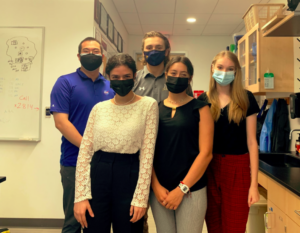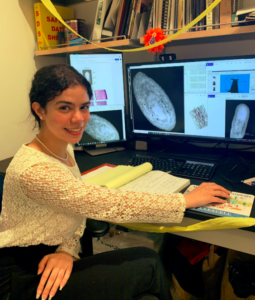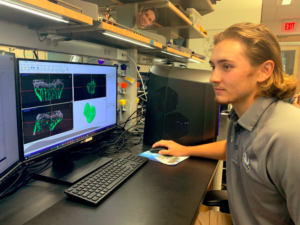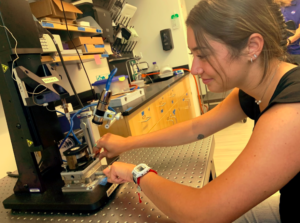Before taking a step into the lab of Dr. Anthony Lau, Associate Professor of Biomedical Engineering, you better strap your space boots and oxygen tank on tightly. As he is busy writing and applying for more grants, Dr. Lau’s research students are in the trenches pursuing independent biomechanics research to support the safety of astronauts exploring our solar system. The research of the students was funded by the NJ Space Grant Summer Fellowship and TCNJ’s Mentored Undergraduate Summer Experience (MUSE).
In this lab, the cosmos are the limit. Last summer, we sat down with each undergraduate explorer to discuss their biomedical engineering missions.
– Anisa Lateef ‘22

(Left to Right) Dr. Anthony Lau, Lara Abdelmohsen (‘22), Jack Felipe (‘23), Michelle Meyers (‘23) & Sabrina Vander Wiele (‘23)
Lara Abdelmohsen ‘22

Hometown: South Brunswick, NJ
Hobbies: Archery, hiking, reading, being a coffee connoisseur, learning new languages (mastered Arabic & Korean, currently working on French)
@ TCNJ: Engineering ambassador giving tours to prospective students, Vice president of BMES (Biomedical Engineering Society), Commuter Club member, SWE (Society of Women Engineers) member, Mindfulness Center member
What kind of stuff are you working on in the lab?
Basically, we just model fishbone scans in order to get information on their mechanical strength and other bone material properties. We have these images of bone scans in a kind of fish called teleost fish (specifically, the herring). The bones are from a special part in the body that’s unique to this fish called intermuscular bone, which is bone that is sandwiched between muscles. We are processing these scans in order to render some 3D reconstruction of the 2D image so we can fully see what is going on in there with the specific pores. These pores have specific pixel intensities in them, so we are suspecting that there is some sort of material in there that gives that bone its specific properties. After we do the image processing, we model the bone scan using a method called micromechanical modeling.
What is the significance of the research you are doing?
These bone scans were given by our collaborators who did the actual tensile testing with the instron machine in their lab. Unlike human bone, they’re strong and elastic bones. Although they looked at the largescale in front of them, we’re looking at very detailed Nano-CTs (high resolution imaging). We’re looking at this because we can take these unique properties in the fish and use them to develop biomaterials, like for implants. This would be more biocompatible with the human body because this material is very natural and organic since it comes from another animal (it’s not synthetic).
What made you want to pursue this type of research?
Freshman year, I attended a lot of Dr. Lau’s Research Tuesday seminars. He would also have his students present to the BME department. When I saw the work Dr. Lau was doing, I realized bones are so cool (how they can fracture and break under space radiation) and I wanted to approach him. To be honest, I did not think he would pick me at all. I felt like this was going to be one of those forgotten dreams. I want to work in the medical field but I don’t want to be a doctor. I want to influence the medical field through research. His students were doing research and I wanted to do research.
I approached him sophomore fall after my sister forcing/heavily encouraging me to (“You have to take the initiative!” “What happens if he says no?” “You tell me, what happens if he says no.” “Nothing?” “Exactly!”). So I went up to him and thankfully he took me on. I remember really hoping I could be like one of those students one day and now I’m here.
Could you describe the lab environment for people who have never experienced something like this before?
It’s a very interactive experience. It’s a mixture of doing literature review for a bit, then working on the actual project for a bit and then writing our abstracts & papers. In the lab, Dr. Lau likes to set up computers and show us how to do all this stuff that we don’t know how to do. He gives us time to experience cutting and polishing bones, cleaning bones with very strange equipment and showing the experimental microindentation machinery. Even if it’s not our project, he gives us an overview of what it’s like and lets us try different things so we get both the experimental and the computational sides of the lab. We also like to have lunch together most of the time. We don’t work hard the whole time, we like to chill and have conversations. Today, during our morning we were talking about how I’m incapable of eating fish, which is ironic because I do research on fish.
Any advice for future students working in a lab?
Definitely you have to take the initiative as my sister said. It’s just that simple, the professor will not know that you are interested in their work unless you actually gather the courage to go up and talk to them about it. Be genuine about it, you know? You’re actually interested in their work, you find this very cool, right? Once you express that and they see that, I don’t see a reason why they would say no.
What’s a fun fact that you’ve learned while doing MUSE?
There seems to be a pattern in nature the way everything happens. I was looking at my fish and they seem to have a center core and then these rings that just build up on top of that very strong core. There’s clearly a pattern to how these concentric rings form so I decided to look up “concentric rings in nature” and I found that this pattern is also found in trees. Trees have a center and then as they age, these rings form around them. So then I was like, “You know what, there must be a reason why this is the way it is”. That drove me to actually want to explore more. My project is so open-ended, but if I can look at the patterns in nature, I can maybe find something similar because things are not coincidental. Hopefully, we could use stuff like this to our advantage. We can try to mimic the properties and patterns we found in the fish and the porosity in the bone to create something that can benefit human beings.
Jack Felipe ‘23

Hometown: Toms River, NJ
Hobbies: hanging out with his baseball teammates, watching movies (a big Star Wars fan), playing video games (love-hate relationship with Rocket League & Call of Duty)
@ TCNJ: Varsity Baseball Team
What kind of stuff are you working on in the lab?
I’m working on finite element analysis, which is computerizing everything. Basically the same tests that we would perform in-person on the actual bones, I do it on the computer. We get these scans that we’re talking about, which is like, say you were to tear your ACL: you would go get a CT scan which breaks up your knee into however many pictures and you put those pictures together to get a 3D image. Then, I take that 3D image, process it and do compression tests on it. I push down on it to get certain results that I want and using those results, I compare them. Right now, we’re looking at rat bones that have been under acute and protracted radiation.
What is the significance of the research you are doing?
In the future, NASA is planning on sending people to more missions on the moon and deep space exploration probably to Mars. As these astronauts leave earth’s atmosphere, they’re not protected anymore. What the atmosphere protects you from is radiation so when astronauts go into space, they’re not protected by the atmosphere anymore and they absorb radiation. That radiation ultimately deteriorates the insides of your bones. We’re trying to figure out if that makes your bones weaker and exactly how weak it makes your bones so NASA can eventually find out how to combat it so nobody gets hurt.
What made you want to pursue this type of research?
I had Dr. Lau for BME 222 (Introduction to Mechanics) and I really liked how he was in that class. Originally, it was that I liked Dr. Lau and how he goes about his business and then eventually I learned more about the research and was like “I’ve never done this before and it’s not what I planned on doing, but it’s interesting so try new things” and I ended up liking it.
Could you describe the lab environment for people who have never experienced something like this before?
It’s much better than classes. Honestly, if I could just do lab work and get credit for it (which you can at TCNJ), I would do that because it’s hands-on. You teach yourself and I’ve learned stuff from Dr. Lau, Michelle and Sabrina. It’s stuff that I probably wouldn’t learn in class. I feel like it’s setting me up for the future better than most classes would.
Any advice for future students working in a lab?
I would apply for everything. Apply for as many lab or undergraduate research opportunities as you can, and pick from the ones you like or think that you would be interested in. I got lucky because I do enjoy what we do and I like everyone in the lab. If there’s something that you have a lot of knowledge about, do it. If there’s something that you think is cool and you’re worried you’re not going to like it, I would say do that because it’s better to have a wider range of knowledge.
What’s a fun fact that you’ve learned while doing MUSE?
Dr. Lau loves food. We share very common interests in loving food. One of our lab’s interesting quirks is that we eat a lot of food. They have gotten a lot of food in the past, but Covid’s put a little stop on it. We’re actually planning on getting food today, I think Dr. Lau wants sushi.
Michelle Meyers ‘23

Hometown: Toms River, NJ
Hobbies: running, reading romance books, watching crime & doctor shows (favorite show is Criminal Minds)
@ TCNJ: Pole Vault for the TCNJ Track Team, member of Theta Tau (Professional Engineering Fraternity)
What kind of stuff are you working on in the lab?
I’m the only one that does actual testing in the lab right now. I do microindentation on rat bones that were exposed to space radiation. Microindentation is a type of material testing where you poke a bone and basically, it just gives back a bunch of different variables and graphs. You can find how stiff a bone, or anything, is.
What is the significance of the research you are doing this summer?
When it comes to space travel, astronauts are really affected by radiation. There’s a range of how much radiation they’re exposed to which is the equivalent of around 150 to 1000 or so chest X-rays. That’s a lot of radiation. There’s been so many studies on how it affects their livers, stomach, intestines and stuff like that but not that many studies on how it affects the material properties of the bones.
It’s important because these astronauts are going into space and there’s so much unknown about it. They need safer gear and safer air crafts to make space travel more safe. Especially with going farther, like going to Mars, there’s a direct relationship between how far away you go from the earth with how strong radiation is. The farther you go, the stronger the radiation is. Therefore, the more we need to protect our astronauts.
What made you want to pursue this type of research?
I had Dr. Lau for BME 222 (Introduction to Mechanics) and you can just hear how passionate he is about his research by how much he talks about it (which is a lot). I never really had any interest in space or anything like that, but after listening to that I’m like “Wow, that’s crazy! Why are we not looking into this stuff?”. I just think it’s cool to do something for a greater cause and actually work for something that might affect people in the future. Obviously, it’s a small group of people that are actually going to space but those people matter a lot for the future of the world.
Could you describe the lab environment for people who have never experienced something like this before?
I didn’t expect how independent it is and how everything relies on what you do for yourself in the lab. It’s your time. Dr. Lau is very geared towards making us more independent with our research. He’s in the room a lot, but I don’t necessarily need to go to him for every single thing I do, which I love. I thought it was going to be Dr. Lau always telling us what to do, but he’s never told me what to do. It’s basically you do stuff on your own time. It’s good for time management.
Any advice for future students working in a lab?
Work really hard because you have a lot of down time. We have an 8 week internship here but there are times where you’re not always looking at data. Even when I wasn’t testing, I was reading papers to try to understand it more because it’s a difficult topic and I didn’t know anything about it. Prepare yourself. Get the most you can out of it because if you don’t put in as much as you want, then you’re not going to get anything out of it because you’re not going to understand anything.
I would also say reach out to a lot of people because you never know what people are looking for and what they need. People are always looking to recruit because lab students are extremely cheap. Just put yourself out there, make connections and start networking.
What’s a fun fact that you’ve learned while doing MUSE?
There’s a very big difference between mice and rats in their bones and different sizes. It’s a very big mistake if you say something’s a rat and it’s actually a mouse (rats are extremely bigger than mice).
Sabrina Vander Wiele ‘23

Hometown: Midland Park, NJ
Hobbies: digital art (able to explore art without needing to bring a bunch of supplies or messes to campus), appreciating Star Wars
@ TCNJ: math/science tutor at the tutoring center for calculus, chemistry & BME courses, member of BMES (Biomedical Engineering Society)
What kind of stuff are you working on in the lab?
We’re looking at rat tibias and connectivity in trabecular bone as a sign of bone health. Dr. Lau calls it the microstructure that I’m looking at. We have rat bones, some of them were irradiated (exposed to radiation), some of them weren’t. Among the irradiated bones, some of them have acute radiation (one large blast) and some of them have protracted radiation (over a time period: do a small blast, give them a few days, do another blast).
I create an image processing sequence where I take the DICOMS (medical imaging information) of the rat bones and upload them into an image processing software (Mimics). I separate the cortical, or the outside part of bone, and trabecular bone, or the spongy center part, and then upload them individually into an image analysis software (Image J). There, I’m able to create 3D models of thickness. I’m analyzing cortical thickness and trabecular thickness. This is a sign of bone health because the thicker the cortical bone, the healthier the bone is.
What is the significance of the research you are doing?
The main worry about sending astronauts to space is how they’re going to come back. What is the condition of their bones when they come back? They don’t know much about radiation, they don’t know if it affects females more than males, they don’t know if acute is affected more than protracted. Right now, NASA considers young females “high risk” for radiation problems with bones, so there’s a time limit for how long young females are allowed in the International Space Station. There’s very little research on who/what it affects more. The two variables we’re mostly looking at are: sex and acute vs. protracted radiation. We want to have an idea of how health will look once they’re back on earth. For me, the thickness would relate to a bone density test, so that’s something I may be able to recommend.
What made you want to pursue this type of research?
Dr. Lau was my advisor and my teacher for Mechanics. I was interested in mechanics, went to one of Dr. Lau’s seminars, spoke to his lab alumni, heard the word “NASA” and perked right up. Dr. Lau talks a lot about how he goes to watch the space shuttles and how he’s sent tests into space before. He’s also very into students making connections with grad schools because a lot of the students that come out of his lab go to grad school. I was just really intrigued on how the student life was in his lab. All the students went to grad school, went into industry and they all loved working with Dr. Lau. That kind of space work really intrigued me, so that was my main reason for being like, “Okay, this sounds like a fun lab”.
Could you describe the lab environment for people who have never experienced something like this before?
Dr. Lau is very hands-off. It’s also very interesting because all of our work kind of intertwines but it’s all very different. It’s definitely a light-hearted environment. We work 8 hours a day but within that time, we’re working and also having fun. If we’re waiting for things to load, we’re playing chess. We also eat lunch together. It’s also really cool working next to people who are also doing research. It’s a combination of just learning and having fun. Dr. Lau is always teaching us new things but we’re also learning things on our own. He always sends us off to learn something, that’s his main thing. He makes us do a “how to” sheet like a cheat sheet. I’ve used some of these cheat sheets from other students and we have lab notebooks that we read through from other students. I really feel like I’m learning from other students when they’re not even there.
Any advice for future students working in a lab?
Start early on trying to find where your interests lie. Another thing is to make connections with teachers whether or not you have had them. And just go to a lot of seminars and make connections with teachers. That’s definitely how I won Dr. Lau’s heart over because I went to his seminar and asked questions.
TCNJ faculty in general are very big on answering any question your heart desires. Don’t be afraid to go out, meet with a professor and find out about their research. If you don’t like it, they’re not offended. You can go out and meet with different people. I definitely liked my advisor first, then the research. You need to like both or else it may be miserable.
What’s a fun fact that you’ve learned while doing MUSE?
I would go into space, but I would shave my head first. Watch a video on how they wash their hair. The water is just clumping and they have to use dry shampoo. It’s just not a good time, so if I was ever going to go to space, I would shave my hair.
If you are an engineering student and did something awesome you want us to know about, email us at: soengweb@tcnj.edu.
